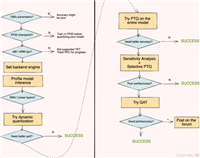在python中,有多种方法可以通过使用各种函数和构造函数来合并字典。在本文中,我们将讨论一些合并字典的方法。
1. 使用方法update()
通过使用python中的update()方法,可以将一个列表合并到另一个列表中。但是在这种情况下,第二个列表被合并到第一个列表中,并且没有创建新的列表。它返回none。
示例:
def merge(dict1, dict2):
return(dict2.update(dict1))
# driver code
dict1 = {'a': 10, 'b': 8}
dict2 = {'d': 6, 'c': 4}
# this returns none
print(merge(dict1, dict2))
# changes made in dict2
print(dict2)
输出
none
{'c': 4, 'a': 10, 'b': 8, 'd': 6}
2. 使用 ** 操作符
这通常被认为是python中的一个技巧,其中使用单个表达式合并两个字典并存储在第三个字典中。使用 ** [星星]是一种快捷方式,它允许您直接使用字典将多个参数传递给函数。使用此方法,我们首先将第一个字典的所有元素传递到第三个字典,然后将第二个字典传递到第三个字典。这将替换第一个字典的重复键。
def merge(dict1, dict2):
res = {**dict1, **dict2}
return res
# driver code
dict1 = {'a': 10, 'b': 8}
dict2 = {'d': 6, 'c': 4}
dict3 = merge(dict1, dict2)
print(dict3) 输出
{'a': 10, 'b': 8, 'd': 6, 'c': 4}
3. 使用 ‘|’ 运算符 (python 3.9)
在python的3.9中,现在我们可以使用“|“运算符来合并两个字典。这是一种非常方便的字典合并方法。
def merge(dict1, dict2):
res = dict1 | dict2
return res
# driver code
dict1 = {'x': 10, 'y': 8}
dict2 = {'a': 6, 'b': 4}
dict3 = merge(dict1, dict2)
print(dict3) 输出
{'x': 10, 'a': 6, 'b': 4, 'y': 8}
4. 使用for循环和keys()方法
def merge(dict1, dict2):
for i in dict2.keys():
dict1[i]=dict2[i]
return dict1
# driver code
dict1 = {'x': 10, 'y': 8}
dict2 = {'a': 6, 'b': 4}
dict3 = merge(dict1, dict2)
print(dict3)输出
{'x': 10, 'y': 8, 'a': 6, 'b': 4}
5. 使用chainmap
在python中合并字典的一种新方法是使用collections模块中的内置chainmap类。这个类允许您创建多个字典的单个视图,对chainmap所做的任何更新或更改都将反映在底层字典中。
以下是如何使用chainmap合并两个字典的示例:
from collections import chainmap
# create the dictionaries to be merged
dict1 = {'a': 1, 'b': 2}
dict2 = {'c': 3, 'd': 4}
# create a chainmap with the dictionaries as elements
merged_dict = chainmap(dict1, dict2)
# access and modify elements in the merged dictionary
print(merged_dict['a']) # prints 1
print(merged_dict['c']) # prints 3
merged_dict['c'] = 5 # updates value in dict2
print(merged_dict['c']) # prints 5
# add a new key-value pair to the merged dictionary
merged_dict['e'] = 6 # updates dict1
print(merged_dict['e']) # prints 6输出
1
3
5
6
使用chainmap合并字典是一种简洁高效的方法,并且允许您轻松地更新和修改合并后的字典。
6. 使用dict构造函数
def merge_dictionaries(dict1, dict2):
merged_dict = dict1.copy()
merged_dict.update(dict2)
return merged_dict
# driver code
dict1 = {'x': 10, 'y': 8}
dict2 = {'a': 6, 'b': 4}
print(merge_dictionaries(dict1, dict2))输出
{'x': 10, 'y': 8, 'a': 6, 'b': 4}
7. 使用dict构造函数和union运算符(|)
此方法使用dict()构造函数和联合运算符(|)合并两个字典。union运算符组合两个字典的键和值,并且两个字典中的任何公共键从第二个字典中获取值。
# method to merge two dictionaries using the dict() constructor with the union operator (|)
def merge(dict1, dict2):
# create a new dictionary by merging the items of the two dictionaries using the union operator (|)
merged_dict = dict(dict1.items() | dict2.items())
# return the merged dictionary
return merged_dict
# driver code
dict1 = {'a': 10, 'b': 8}
dict2 = {'d': 6, 'c': 4}
# merge the two dictionaries using the merge() function
merged_dict = merge(dict1, dict2)
# print the merged dictionary
print(merged_dict)输出
{'d': 6, 'b': 8, 'c': 4, 'a': 10}
8. 使用reduce()方法
from functools import reduce
def merge_dictionaries(dict1, dict2):
merged_dict = dict1.copy()
merged_dict.update(dict2)
return merged_dict
dict1 = {'a': 10, 'b': 8}
dict2 = {'d': 6, 'c': 4}
dict_list = [dict1, dict2] # put the dictionaries into a list
result_dict = reduce(merge_dictionaries, dict_list)
print(result_dict)
输出
{'a': 10, 'b': 8, 'd': 6, 'c': 4}
到此这篇关于python实现合并两个字典的8种方法的文章就介绍到这了,更多相关python 合并字典内容请搜索代码网以前的文章或继续浏览下面的相关文章希望大家以后多多支持代码网!







发表评论